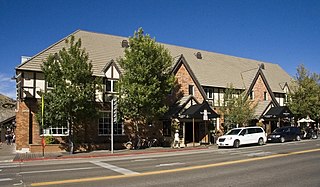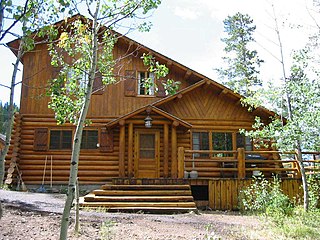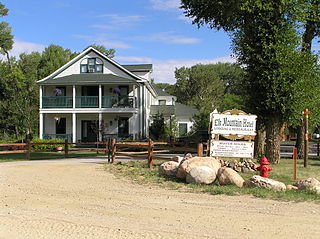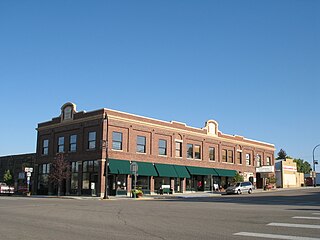
Menor's Ferry was a river ferry that crossed the Snake River near the present-day Moose, Wyoming, United States. The site was homesteaded by Bill Menor in 1892-94, choosing a location where the river flowed in a single channel, rather than the braided stream that characterizes its course in most of Jackson Hole. During the 1890s it was the only homestead west of the river. Menor's homestead included a five-room cabin, a barn, a store, sheds and an icehouse on 148 acres (60 ha), irrigated by a ditch from Cottonwood Creek and at times supplemented by water raised from the Snake River by a waterwheel. Menor operated the ferry until 1918, selling to Maude Noble, who continued operations until 1927, when a bridge was built at Moose.

The 4 Lazy F Ranch, also known as the Sun Star Ranch, is a dude ranch and summer residence in Jackson Hole, Wyoming, built by the William Frew family of Pittsburgh in 1927. The existing property was built as a family retreat, not as a cattle ranch, in a rustic style of construction using logs and board-and-batten techniques. The historic district includes seven cabins, a lodge, barn corral and smaller buildings on the west bank of the Snake River north of Moose, Wyoming. The property was added to the National Register of Historic Places in 1990.

Ten Sleep Mercantile, also known as Ten Sleep Hardware, is an example of a typical small-town general store. Located in Ten Sleep, Wyoming, it has been the focal point of the town since it was built in 1905 by H.T. Church. Upon Church's death in 1918 the property was bought by Buffalo businessman and rancher Alex Healy (Rancher) in an agreement that brought the store under the control of Paul Frison. Frison, who later served as mayor of Ten Sleep and as a Wyoming state legislator, operated the store from 1918 to 1943.

The Wort Hotel was built in downtown Jackson, Wyoming, United States by brothers John and Jess Wort, who were significant figures in the transformation of the economy of Jackson Hole from ranching to tourism. The somewhat Tudor-style building was the first luxury hotel in Jackson. The two-story building features brick facing, with half-timbering and stucco on the second floor and a series of gables facing the street.

The Brinkerhoff is a historic lodge in Grand Teton National Park on the shore of Jackson Lake. It is the last remaining example of a forest lease vacation lodge in the park. The log house and caretaker's lodge were designed by architect Jan Wilking of Casper, Wyoming and were built in 1946 in what was then U.S. Forest Service land for the Brinkerhoff family. After the creation of Grand Teton National Park, the National Park Service acquired the property and used it for VIP housing. Among the guests at the Brinkerhoff were John F. Kennedy and Richard M. Nixon. The lodge is also notable as a post-war adaptation of the rustic style of architecture. The interior is an intact example of this transitional style.

The Masonic Temple in downtown Casper, Wyoming is a Masonic hall, built in 1914 during a boom time initiated by the development of the Salt Creek Oil Field. Located on a corner site, the temple remains essentially as it was designed by Casper architect Homer F. Shaffer. The four story light-colored brick building rests on a raised basement and is topped by a crenelated parapet. The original windows have been replaced with vinyl units but retain the one-over-one appearance of the originals. Windows extend over the west and south sides. The north side is blank, while the east side is the building's rear facade and has fire escapes and a few windows.

Teapot Rock, also Teapot Dome, is a distinctive sedimentary rock formation and nearby oil field in Natrona County, Wyoming that became the focus of the Teapot Dome bribery scandal during the administration of President Warren G. Harding. The site was listed on the National Register of Historic Places in 1974.

The Worland Ranch is a historic district that includes the farmstead established in 1900 by C.F. "Dad" Worland near his namesake town of Worland, Wyoming, United States. The site was in fact the original townsite, with the Worland post office located on the grounds. The present town developed just to the east on the broad flatlands east of the Bighorn River. The original townsite is commemorated by an inscribed stone marker.

The Alex Halone House in Thermopolis, Wyoming, United States, was built by Finnish immigrant Alex Halone for his personal residence in 1909–1910. Halone, a stonemason, built several stone structures in Thermopolis. Three generations of the Halone family were stonemasons. The grounds include a log Finnish sauna built by Alex and Eugene Halone with assistance from Lauri Suikaonen in 1946–51.

The historical buildings and structures of Grand Teton National Park include a variety of buildings and built remains that pre-date the establishment of Grand Teton National Park, together with facilities built by the National Park Service to serve park visitors. Many of these places and structures have been placed on the National Register of Historic Places. The pre-Park Service structures include homestead cabins from the earliest settlement of Jackson Hole, working ranches that once covered the valley floor, and dude ranches or guest ranches that catered to the tourist trade that grew up in the 1920s and 1930s, before the park was expanded to encompass nearly all of Jackson Hole. Many of these were incorporated into the park to serve as Park Service personnel housing, or were razed to restore the landscape to a natural appearance. Others continued to function as inholdings under a life estate in which their former owners could continue to use and occupy the property until their death. Other buildings, built in the mountains after the initial establishment of the park in 1929, or in the valley after the park was expanded in 1950, were built by the Park Service to serve park visitors, frequently employing the National Park Service Rustic style of design.

The State Bank of Antler, also known as the Antler Square Building, is a historic building in Antler, North Dakota, located in the center of the town's public square.

The Boscawen Academy and Much-I-Do Hose House are a pair of historic civic buildings in Boscawen, New Hampshire. Now owned by the Boscawen Historical Society, these two buildings played a significant role in the civic history of the town for over 150 years, and were listed on the National Register of Historic Places in 1980.
The Merchants National Bank Building is a two-story, red brick building in Lehigh, Oklahoma, located at the southwest corner of Main Street and Railway Street. It was one of two banks that served Lehigh during the town's mining boom. It is listed on the National Register of Historic Places. It is historically significant because it represents the economic growth and decline of Lehigh and exemplifies Late Victorian Renaissance architecture.
The Jelm-Frank Smith Ranch Historic District, also known as Old Jelm and Cummins City, comprises an area of bottomland on the Laramie River near Woods Landing, Wyoming where the mining boomtown of Cummins City, Wyoming was established in 1880. Gold had been discovered in the nearby mountains and the town was established by W.S. "Buck" Bramel and John Cummins. In 1881 Cummins City was described as having about 100 houses and a hotel. By this time the camp was already declining, and by 1886 mining in the district was largely inactive. However, in the 1890s copper was discovered in the Sierra Madre and Medicine Bow ranges. Cummins City was revived as Jelm in 1900. This boom also declined and in 1930 Jelm's population was 50.

The Elk Mountain Hotel, also known as the John S. Evans Hotel, Mountain View Hotel and Grandview Hotel was built in 1905 in Elk Mountain, Wyoming on the bank of the Medicine Bow River. The two-story wood-frame building was built next to the 1880 Garden Spot Pavilion, a dance hall that was a social center in an otherwise isolated portion of Wyoming. The hotel was built by John Evans, the owner of the Elk Mountain Saloon, who in 1903 had acquired the Pavilion. Evans catered to the mining trade through the 1930s. By that time better roads allowed tourism to increase, and the hotel provided accommodation to hunters and tourists. Evans sold the property in 1947 to Mark and Lucille Jackson, who remodeled the hotel and the pavilion.

The Stockgrowers Bank, also known as the Dixon Town Hall, was built in Dixon, Wyoming in 1916. The decorated concrete masonry building was the bank's headquarters until the bank was dissolved in 1923. Following the bank's demise the building served as a soda fountain into the 1940s, which was followed by a store, then the Little Snake River Veterans of Foreign Wars Post 10051 hall. In 1975 it became the town hall.

The Willis House is a historic residence in Encampment, Wyoming, United States, that is listed on the National Register of Historic Places.

Commerce Block is a commercial building in Glenrock, Wyoming, built in 1917 during the Wyoming oil boom of the early 20th century. The nearby Big Muddy oil field brought prosperity to Glenrock, stimulating the growth of the town's commercial district. The building was built for the Glenrock Investment Company, a consortium of local investors, by Edward R. Reavill. The building housed the Glenrock State Bank until 1934. Other businesses in the building included a bar, a billiard parlor and a drug store. The Empress Theater took a two-story space in the east wing of the block. By the late 1920s the oil boom had ended and the theater passed through several owners, closing intermittently. In 1939 it was renamed the Wyoma Theater and had a prominent marquee.

The Hotel Higgins, Tabor Hotel or Higgins Hotel was built in 1916-1917 during the oil boom in Glenrock, Wyoming. It was built for John E. Higgins, who was a local rancher, legislator and oil business investor, and his wife Josephine Amoretti Higgins. It was designed by architect Edward Reavill, and it opened on May 9, 1917. After the accidental death of Josephine in 1924 and the death of John in 1926 the property was disputed by their heirs. This was resolved in 1942 when the hotel was sold to Dr. and Mrs. Leonard Tabor at a tax sale, and the hotel became the Tabor Hotel. After several new owners the hotel became the Hotel Higgins again in 1978.

The Columbus Civic Center is a civic center, a collection of government buildings, museums, and open park space in Downtown Columbus, Ohio. The site is located along the Scioto Mile recreation area and historically was directly on the banks of the Scioto River.



















